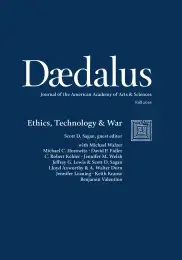The Nuclear Necessity Principle: Making U.S. Targeting Policy Conform with Ethics & the Laws of War
In 2013, Obama administration spokesmen stated that all U.S. nuclear war plans “apply the principles of distinction and proportionality and seek to minimize collateral damage to civilian populations and civilian objects.” We analyze U.S. nuclear policy documents and argue that major changes must be made if U.S. nuclear war plans are to conform to these principles of just war doctrine and the law of armed conflict. We propose that the U.S. president announce a commitment to a “principle of necessity,” committing the United States not to use nuclear weapons against any military target that can be destroyed with reasonable probability of success by a conventional weapon. Such a doctrinal change would reduce collateral damage from any nuclear strike or retaliation by the United States and would, we argue, make our deterrent threats more credible and thus more effective.
The world will note that the first atomic bomb was dropped on Hiroshima, a military base. That was because we wished in the first attack to avoid, insofar as possible, the killing of civilians.
– Harry S. Truman, radio address to the American people, August 9, 19451
Truman said he had given orders to stop atomic bombing. He said the thought of wiping out another 100,000 people was too horrible. He didn't like the idea of killing, as he said “all those kids.”
– Henry Wallace, diary, August 10, 19452
Applying just war doctrine and the laws of war to planning for a nuclear war may seem like an impossible task. After all, the destructive power of nuclear weapons is so massive that most conceivable uses of such weapons, even against legitimate military targets, are likely to kill multitudes of innocent people. Strategists can imagine limited uses of nuclear weapons – a single detonation against a ship at sea or an isolated military target in the desert – that might meet stringent ethical and legal standards, but these are mostly imaginary scenarios, far removed from the real concerns of policy-makers and planners.3 This state of affairs naturally leads to grave doubts about whether the principles of distinction (or noncombatant immunity) and proportionality can be meaningful concepts in actual nuclear war planning. A valuable literature about ethics and nuclear weapons exists in philosophy and political science, but most of this work focuses on the question of whether it is ethical to make a threat that would be immoral to execute. And even reluctant supporters of nuclear deterrence have lingering doubts. “Nuclear weapons explode the theory of just war,” Michael Walzer has written elsewhere. “The reason for our hesitancy and self-doubt is the monstrous immorality of what our policy contemplates, an immorality we can never hope to square with our understanding of justice in war.”4
Yet it is this monstrous immorality that lies at the heart of how most policy-makers think and talk about deterrence. The dominant logic underpinning nuclear deterrence has been about punishment to noncombatants. The dominant language, however, has used more clinical or euphemistic formulations, like “unacceptable damage,” “assured destruction,” “countervalue targeting,” or “holding at risk that which an adversary values most.”
At the same time, the U.S. government has tasked the military with creating plans to deter, and to inflict damage if deterrence fails, in ways that comply with the law of armed conflict (LOAC). The Obama administration's 2013 guidance on the employment, or use, of nuclear weapons, for example, explicitly directs that “all plans must also be consistent with the fundamental principles of the law of armed conflict. Accordingly, plans will, for example, apply the principles of distinction and proportionality and seek to minimize collateral damage to civilian populations and civilian objects. The United States will not intentionally target civilian populations or civilian objects.”5 . . .
